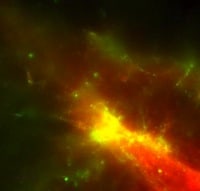
The goal of the modular molecular composite nanosystems (MMCNs) path to atomically precise manufacturing is to exploit million-atom-scale DNA frameworks to assemble and coordinate molecular components to build complex functional nanostructures. Last year we cited work in which molecular motor proteins were used to transport synthetic DNA cargos along a 25-nm-diameter protein track composed of microtubules, the networks used to transport molecular cargo in human and other eukaryotic cells. Demonstrating another way in which to use these molecular components for similar purposes, other researchers have now used DNA nanotechnology to organize and control networks for transporting molecular cargo by incorporating molecular motors into different types of functional nanostructures. A hat tip to ScienceDaily for reprinting this Oxford University press release “All aboard the nanotrain network“:
Tiny self-assembling transport networks, powered by nano-scale motors and controlled by DNA, have been developed by scientists at Oxford University and Warwick University.
The system can construct its own network of tracks spanning tens of micrometres in length, transport cargo across the network and even dismantle the tracks.
The work is published in Nature Nanotechnology [abstract] ….
Researchers were inspired by the melanophore, used by fish cells to control their colour. Tracks in the network all come from a central point, like the spokes of a bicycle wheel. Motor proteins transport pigment around the network, either concentrating it in the centre or spreading it throughout the network. Concentrating pigment in the centre makes the cells lighter, as the surrounding space is left empty and transparent.
The system developed by the Oxford University team is very similar, and is built from DNA and a motor protein called kinesin. Powered by ATP fuel, kinesins move along the micro-tracks carrying control modules made from short strands of DNA. ‘Assembler’ nanobots are made with two kinesin proteins, allowing them to move tracks around to assemble the network, whereas the ‘shuttles’ only need one kinesin protein to travel along the tracks.
‘DNA is an excellent building block for constructing synthetic molecular systems, as we can program it to do whatever we need,’ said Adam Wollman, who conducted the research at Oxford University’s Department of Physics. ‘We design the chemical structures of the DNA strands to control how they interact with each other. The shuttles can be used to either carry cargo or deliver signals to tell other shuttles what to do.
‘We first use assemblers to arrange the track into ‘spokes’, triggered by the introduction of ATP. We then send in shuttles with fluorescent green cargo which spread out across the track, covering it evenly. When we add more ATP, the shuttles all cluster in the centre of the track where the spokes meet. Next, we send signal shuttles along the tracks to tell the cargo-carrying shuttles to release the fluorescent cargo into the environment, where it disperses. We can also send shuttles programmed with ‘dismantle’ signals to the central hub, telling the tracks to break up.’
This demonstration used fluorescent green dyes as cargo, but the same methods could be applied to other compounds. As well as colour changes, spoke-like track systems could be used to speed up chemical reactions by bringing the necessary compounds together at the central hub. More broadly, using DNA to control motor proteins could enable the development of more sophisticated self-assembling systems for a wide variety of applications.
Like last year’s work cited above, this work with microtubule tracks extends the distance scale over which DNA nanotechnology may be useful from 100s of nanometers to 10s of micrometers. The news release includes a 20-second video showing the transport of the dye cargo to the center of the network, followed by the release of the dye in response to different molecular shuttles bearing the release signal.
—James Lewis, PhD

